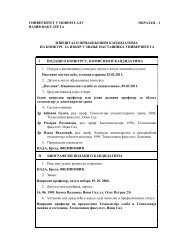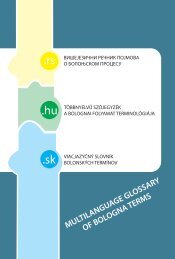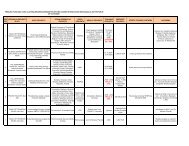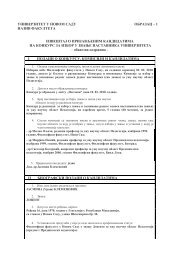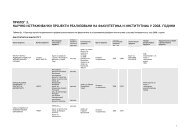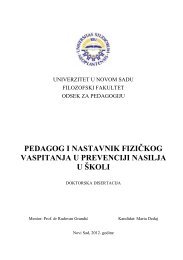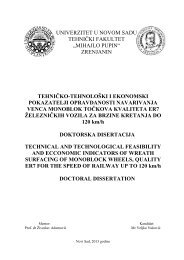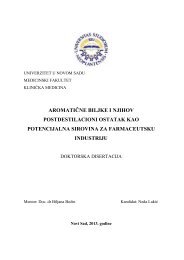Intercultural competence as an aspect of the communicative ...
Intercultural competence as an aspect of the communicative ...
Intercultural competence as an aspect of the communicative ...
Create successful ePaper yourself
Turn your PDF publications into a flip-book with our unique Google optimized e-Paper software.
e<strong>as</strong>ily’ (Oksaar 1990: 242), <strong>as</strong> <strong>the</strong>ir linguistic fluency might be mistakenly seen <strong>as</strong> a sign<br />
<strong>of</strong> being interculturally savvy, which need not be <strong>the</strong> c<strong>as</strong>e. The possible incongruous<br />
behaviour by such a learner would <strong>the</strong>n be even more disapproved by <strong>the</strong> particip<strong>an</strong>ts in<br />
<strong>an</strong> intercultural exch<strong>an</strong>ge, perhaps even more th<strong>an</strong> with learners <strong>of</strong> lower pr<strong>of</strong>iciency,<br />
where intercultural ‘slips’ might be <strong>as</strong>cribed to <strong>the</strong> inadequate l<strong>an</strong>guage use.<br />
Trying to explain <strong>the</strong> situation in foreign l<strong>an</strong>guage teaching in Britain in <strong>the</strong> late<br />
1980s <strong>an</strong>d early 1990s, Byram et al. (1991) state that cultural studies are not present in<br />
foreign l<strong>an</strong>guage cl<strong>as</strong>ses for a number <strong>of</strong> re<strong>as</strong>ons: <strong>the</strong>re is a greater focus on grammar <strong>an</strong>d<br />
literature, teachers are uncertain <strong>as</strong> to what to include in culture teaching <strong>an</strong>d <strong>of</strong>ten have<br />
to resort to <strong>the</strong>ir own experiences to make judgments related to culture. There is little<br />
interdisciplinary research <strong>an</strong>d collaboration <strong>as</strong> well <strong>as</strong> <strong>the</strong> lack <strong>of</strong> <strong>the</strong>oretical guidelines<br />
for teachers. Finally, <strong>the</strong> teacher h<strong>as</strong> to be very flexible when accepting students’<br />
interpretations <strong>an</strong>d opinions, which goes against a ra<strong>the</strong>r positivistic tradition in teaching.<br />
In terms <strong>of</strong> methodology, <strong>the</strong>re is a dilemma that ‘strategies proposed in cl<strong>as</strong>s <strong>an</strong>d used<br />
for solving or describing <strong>an</strong> intercultural encounter should be <strong>the</strong> ones considered correct<br />
or adequate’ (M<strong>an</strong>jarrés 2009: 147). As it h<strong>as</strong> been mentioned, <strong>as</strong>sessment also presents a<br />
challenge, <strong>an</strong>d import<strong>an</strong>t questions are whe<strong>the</strong>r education should prescribe attitudes <strong>an</strong>d<br />
whe<strong>the</strong>r intercultural <strong>competence</strong> should be evaluated separately from linguistic <strong>an</strong>d<br />
whe<strong>the</strong>r ‘levels <strong>of</strong> <strong>competence</strong> c<strong>an</strong> be defined’ (ibid).<br />
While <strong>the</strong> practices have not ch<strong>an</strong>ged much since <strong>the</strong> late 1980s <strong>an</strong>d early 1990s,<br />
<strong>the</strong>re h<strong>as</strong> been <strong>an</strong> intuitive view that culture, cultural elements, underst<strong>an</strong>ding <strong>of</strong> o<strong>the</strong>r<br />
cultures should be included in FLT. With <strong>the</strong> native speaker ce<strong>as</strong>ing to be <strong>an</strong> ideal to<br />
strive to in both linguistic <strong>an</strong>d sociolinguistic <strong>competence</strong>, including ICC h<strong>as</strong> even more<br />
grounds 18 .<br />
Authors who try to bridge culture <strong>an</strong>d l<strong>an</strong>guage, such <strong>as</strong> Byram, Scarino (2009),<br />
Kramsh (1993), Risager (1998), strive to show that l<strong>an</strong>guage courses should have a strong<br />
intercultural component for a number <strong>of</strong> re<strong>as</strong>ons. For example, Scarino (2009) sees<br />
intercultural l<strong>an</strong>guage learning is ‘about how l<strong>an</strong>guage <strong>an</strong>d culture come into play in<br />
creating <strong>an</strong>d exch<strong>an</strong>ging me<strong>an</strong>ing’ (2009: 69). Students develop <strong>an</strong> ability ‘to recognise<br />
<strong>an</strong>d integrate into <strong>the</strong>ir communication <strong>an</strong> underst<strong>an</strong>ding <strong>of</strong> <strong>the</strong>mselves <strong>as</strong> already situated<br />
in <strong>the</strong>ir own l<strong>an</strong>guage(s) <strong>an</strong>d culture(s) when <strong>the</strong>y communicate with o<strong>the</strong>rs’ (Scarino<br />
2009: 69). Similarly, students learn to recognise that o<strong>the</strong>r people also perceive<br />
18 The figures show that up to 70% <strong>of</strong> interaction in English is between non-native speakers, which should<br />
be reflected in sociolinguistic, pragmatic <strong>an</strong>d ICC elements that should be included in FLT<br />
69



